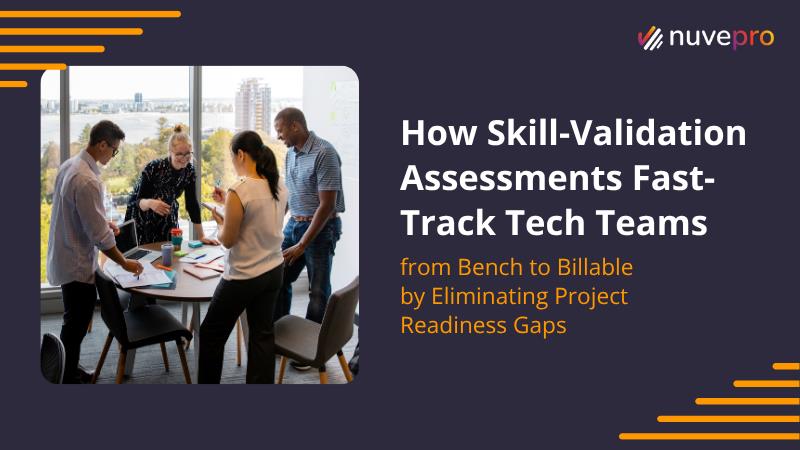In today’s dynamic job market, the demand for skilled professionals is ever-increasing. With the advent of cloud computing and digital transformation, the landscape of employment has shifted towards tech-centric roles that require specialized knowledge and expertise. In this fast-paced environment, maintaining the gold standard of education is paramount, and this is where proctoring and assessment integrity play a pivotal role.
But first, let’s break it down.
What is proctoring?
Proctoring, in essence, refers to the process of supervising and overseeing examinations to prevent cheating or misconduct. The goal remains consistent: to uphold the integrity of assessments and safeguard their credibility.
What is assessment?
Now, let’s delve into the concept of assessment itself. Assessments serve as the yardstick by which a learner’s knowledge, skills, and capabilities are measured. Assessment integrity, therefore, pertains to the fidelity and honesty with which these evaluations are conducted and evaluated. By accurately gauging students’ knowledge and skills, assessments serve as a reliable indicator of their readiness for the workforce.
But why is proctoring and assessment integrity so crucial, especially in the context of job readiness?
The answer lies in its profound implications for learners and employers alike. By maintaining rigorous standards of assessment integrity, educational institutions ensure that graduates possess the requisite skills and competencies demanded by the workforce.
Proctoring and assessment integrity are foundational pillars within hands-on labs platforms, ensuring the credibility and trustworthiness of practical learning experiences. These experiential learning platforms utilize robust proctoring measures and stringent assessment protocols to create a safe controlled environment where learners can engage with real-world scenarios under supervised conditions. Through features like live monitoring, and activity tracking, proctored hands-on lab platforms guarantee the authenticity of learners’ interactions within the learning platform, mitigating the risk of academic dishonesty and ensuring the validity of their skill assessments.
Furthermore, these platforms offer a comprehensive array of tools and resources to support learners throughout their learning journey. From interactive tutorials/content and guided projects to performance analytics/feedback mechanisms, these proctored hands-on labs platforms empower learners to develop practical hands on practice skills and gain valuable hands-on experience in deploying, managing, and optimizing cloud infrastructure. By simulating real-world scenarios and providing opportunities for experimentation and exploration, these platforms facilitate deep learning and skill mastery, preparing learners for the complexities and real world challenges of modern cloud-centric roles.
Herein lies the transformative power of assessments conducted with integrity.
Moreover, they provide invaluable feedback to learners, pinpointing areas for improvement and guiding their professional development journey.
Indeed, assessment integrity goes hand in hand with skill development and hands-on learning. Through rigorous assessments, students are compelled to apply theoretical knowledge in practical contexts, honing their problem-solving abilities and critical thinking skills. This experiential learning approach not only enriches their academic experience but also equips them with the practical acumen essential for success in the workplace.
Moreover,
The journey towards job readiness is intrinsically linked to the pursuit of academic excellence – a pursuit that hinges upon maintaining the highest standards of assessment integrity. Through comprehensive oversight and meticulous supervision, educational institutions uphold these standards, ensuring that assessments accurately reflect students’ capabilities and readiness for the workforce.
Why Proctoring and Assessment Integrity Matter
- Academic Excellence: Ensuring the Highest Standards
At the heart of proctoring and assessment integrity lies the pursuit of academic excellence. By upholding assessment integrity through rigorous proctoring, institutions can ensure that the highest standards of academic quality are maintained. Without rigorous oversight, the credibility of qualifications diminishes, undermining the value of education itself. Therefore, maintaining assessment integrity is not just a matter of ethics; it’s essential for safeguarding the reputation of educational institutions and the trust of employers.
- Comprehensive Oversight: Meticulous Supervision
Meticulous supervision is the cornerstone of assessment integrity. Proctoring serves as a safeguard against academic dishonesty, ensuring that students are evaluated based on their genuine understanding of the subject matter, leaving no room for malpractice. Whether it’s through in-person invigilators or advanced monitoring systems, comprehensive oversight guarantees the authenticity of assessments. This comprehensive oversight fosters a culture of fairness and transparency, instilling confidence in both learners and educators.
- Subjective Assessments: Bridging Skill Gaps
Subjective assessments play a pivotal role in this process. In today’s dynamic job market, success hinges not only on theoretical knowledge but also on practical skills. Unlike traditional MCQ’s, subjective assessments allow students to showcase their technical skills. By tracking students’ progress effectively, these skill assessments bridge skill gaps and provide tailored support to nurture their strengths and address their weaknesses. This personalized approach bridges the divide between academia and industry, ensuring that graduates are equipped to tackle real-world challenges head-on.
- Job Readiness: Equipping Students for Success
Consider this: in today’s highly competitive job market, employers seek candidates who not only possess academic qualifications. Proctoring and assessment integrity play a pivotal role in this journey towards job readiness. By imparting job-ready skills and fostering hands-on learning experiences, educational institutions empower students to excel in their chosen fields. From technical skill development to critical thinking and problem-solving skills, these skills not only enhance employability but also lay the foundation for lifelong success.
Striving for Excellence
Proctoring and assessment integrity are indispensable pillars of education, especially in the context of job readiness. By maintaining the gold standard of academic excellence, ensuring comprehensive oversight, and fostering the development of job-ready skills, these practices empower learners to succeed in their chosen careers. As educators and institutions continue to prioritize proctoring and assessment integrity, they reaffirm their commitment to excellence and ethical conduct, shaping future professionals who are not only competent but also principled contributors to society.




